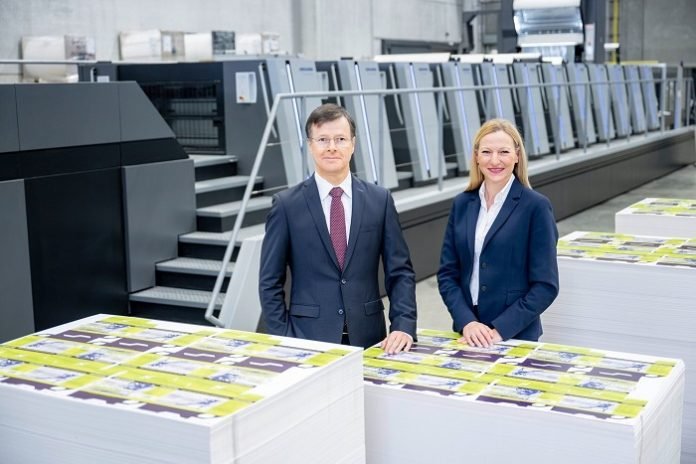
Heidelberg exceeded its targets in the challenging financial year 2022/2023 – generating sales of €2.435 billion (US$ 2.63 billion) compared with €2.183 billion (US$ 2.36 Billion) in the previous year, which represents an increase of around 12%. The adjusted operating result rose from 5.1% to 7.2%. The free cash flow was positive at €72 million (US$ 76.60 million, but this figure benefited from non-recurring effects. 1 Euro is equivalent to US$1.08 as per present market rates.
“We achieved a good outcome in a challenging environment in the financial year just closed,” says Heidelberg CEO Ludwin Monz. “Faced with further cost increases and a level of profitability that remains low, Heidelberg is initiating a value creation program,” he adds. The aim is to further boost the company’s financial strength and step-up investments in growth areas.
The new business strategy will lay the foundation for future investments. With its dual-track strategy, Heidelberg is pursuing two key strategic approaches. Firstly, the company is looking to make an impression on the printing market beyond its business with sheetfed offset presses, especially in the packaging market and digital printing. And, secondly, as it has already done with its wallbox business, Heidelberg will be unlocking new markets alongside its core business.
Targeting a higher free cash flow
To deliver innovation and, in particular, the associated growth, Heidelberg requires the necessary resources – whether to further strengthen its product portfolio in the growing packaging sector or to fund a development budget for the successful expansion of digital printing. With this in mind, the company is looking to significantly increase its free cash flow in the medium term. “We will provide and redistribute the resources for growth through our own internal efforts so as to successfully implement our growth strategy,” explains Heidelberg CFO Tania von der Goltz. That particularly applies to the market environment, which remains challenging and shapes the outlook for 2024.
Successful year in a difficult economic environment
Thanks to a strong final quarter, sales in financial year 2022/2023 were slightly higher than the forecast level of €2.3 billion, amounting to around €2.435 billion (previous year: €2.183 billion). Strong growth in the packaging solutions segment made a particular contribution to the result. The order backlog on 31 March, 2023, remained high at around €848 million (previous year €901 million).
Price adjustments and positive sales developments had a particular impact on EBITDA. At 8.6%, the EBITDA margin exceeded the target of at least 8 percent. Adjusted for earnings from the sale of fixed assets, the EBITDA margin was 7.2% (previous year: 5.1%). Due to the higher absolute EBITDA level and financial and tax results that benefited from non-recurring relief, the net result after taxes amounted to €91 million. This result was thus much better than the predicted slight improvement on the previous year’s figure (€33 million). It also exceeded market expectations, which had already moved beyond the original forecast in the course of the financial year.
Increased investments in packaging and digital printing
As the global demand for packaged goods continues to increase, packaging and label printing is enjoying particular growth, making it an important core segment for Heidelberg. The packaging solutions segment already accounts for around half of the company’s sales. This proportion has gradually increased in recent years, a development to which innovations have contributed. The new generation of Speedmaster XL 106 sheetfed offset presses enables folding carton manufacturers, in particular, to increase their net output by up to 10 percent. The Boardmaster flexographic web printing system, a completely new development, doubles the productivity of price-sensitive folding carton printing compared to the predecessor model.
Heidelberg intends to use this technology to support its strategy and growth. In line with its dual-track strategy, it is focusing on growth in digital printing – a segment that is enjoying the strongest growth in the label market, with a rate of around 6 percent. The company is looking to build on its position in this market with Gallus One, the first fully digital and highly automated label printing system.
Thanks to its charging solutions for electric cars, Heidelberg has successfully positioned itself in the growth market of domestic electric mobility in Germany through its subsidiary Amperfied GmbH. To reach a larger customer base in the future, the company is further driving its expansion into other European countries. A wallbox with a solar function is also being added to the product portfolio to benefit from the growing number of domestic photovoltaic installations.
Outlook for next year
Financial year 2023/2024 will continue to be affected by exceptionally challenging conditions, such as increasing material, energy, and personnel costs. Heidelberg is intending to carry on compensating for this by increasing its sales prices.
Weighing up the opportunities and risks – and assuming the global economy does not see weaker growth than is forecast by the relevant institutes, or even go into recession – Heidelberg expects sales for financial year 2023/2024 in line with the previous year’s figure (previous year: €2.435 billion). A further supposition in this context is that there will be no substantial changes in key exchange rates for the company’s business activities.
Rising production costs are likely to have a particularly negative impact on results. Energy costs are also expected to be higher than in the previous year, which benefited from favorable hedging transactions. To compensate for these effects, Heidelberg is intending to continue increasing the prices of its products. The adjusted EBITDA margin is therefore expected to remain at the previous year’s figure (previous year: 7.2 percent). Results in the print solutions and packaging solutions segments are likely to develop in line with the respective market trend, while the technology solutions segment’s profit contribution is expected to be slightly better than in the previous year.

















